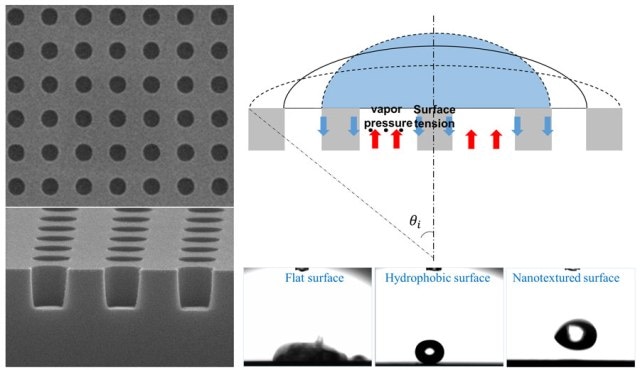May 18 2016
Combining superhydrophobic surfaces with Leidenfrost levitation — imagine a water droplet soaring over a hot surface and not having any physical contact with it — has been studied widely over the past decade by scientists in the hope of uncovering the holy grail of water-repelling surfaces.
 The kinetic energy is transferred into the surface energy with small energy dissipation by the Cassie surface, which facilitates the droplet’s rebound repeatedly until the capillary pressure outweighs the vapor pressure. (Credit- Lee and Song)
The kinetic energy is transferred into the surface energy with small energy dissipation by the Cassie surface, which facilitates the droplet’s rebound repeatedly until the capillary pressure outweighs the vapor pressure. (Credit- Lee and Song)
A team of South Korean scientists from Dankook University and Seoul National University reported an unusual water droplet-bouncing occurrence produced by Leidenfrost levitation on nanotextured surfaces in Applied Physics Letters, from AIP Publishing.
Wettability plays a key role in determining the equilibrium contact angles, contact angle hysteresis, and adhesion between a solid surface and liquid, as well as the retraction process of a liquid droplet impinged on the surface.
Doo Jin Lee, Postdoctoral Researcher, Department of Materials and Engineering, Seoul National University
Nonwetting surfaces incline to be formed by either one of the two methods. “First, textured surfaces enable nonwettability because a liquid can’t penetrate into the micro- or nano-features, thanks to air entrapment between asperities on the textured materials,” Lee said.
Or, second, the Leidenfrost effect “can help produce a liquid droplet dancing on a hot surface by floating it on a cushion of its own vapor,” he said. “The vapor film between the droplet and heated surface allows the droplet to bounce off the surface—also known as the ‘dynamic Leidenfrost phenomenon.’”
Lee and his team created a unique “nonwetting, nanotextured surface” to probe into the impact of dynamic Leidenfrost effect on the material.
Our nanotextured surface was verified to be ‘nonwetting’ via thermodynamic analysis. This analytical approach shows that the water droplet isn’t likely to penetrate into the surface’s nanoholes, which is advantageous for designing nonwetting, water-repellant systems. And the water droplet bouncing was powered by the synergetic combination of the nonwetting surface—often called a ‘Cassie surface’—and the Leidenfrost effect.
Doo Jin Lee, Postdoctoral Researcher, Department of Materials and Engineering, Seoul National University
While comparing the nanotextured surface and hydrophobic surface, the researchers found that improved water droplet bouncing was formed by the collective effect of the Leidenfrost levitation and the nonwetting Cassie state.
“A thermodynamic approach predicts the nonwettability on the nanotextured surface, and a scaling law between the capillary and vapor pressure of the droplet explains the mechanism of the dynamic Leidenfrost phenomenon,” said Lee.
These outcomes should “be of value for a wide range of research areas, such as the study of nonwetting surfaces by the Leidenfrost effect and nanotextured features, enhanced liquid droplet bouncing, and film boiling of liquid droplets on heated Cassie surfaces,” he stated.
Significantly, the team’s work advances the basic understanding of droplet-bouncing and the dynamic Leidenfrost droplet levitation occurrences on nanoengineered and hydrophobic surfaces. This indicates that it would be beneficial in the future to produce highly water-repellant surfaces for industrial purpose like anti-fouling coatings, self-cleaning windows, roof tiles, windshields, exterior paints, and textiles.
Our future work will focus on developing multiscale structures with microscale and nanoscale regularities, and explore the nonwetting characteristics of their surfaces with the dynamic Leidenfrost effect.
Doo Jin Lee, Postdoctoral Researcher, Department of Materials and Engineering, Seoul National University